Nicola Cornick's Blog, page 25
November 18, 2011
Scotland 2 – The Red Fox!
 Okay, so today's post is a bit of a historical murder mystery!
Okay, so today's post is a bit of a historical murder mystery!
On day 2 of our Scottish holiday we were staying in Ballachulish (see previous post) and went for a very wet walk – it was pouring with proper Scottish rain – to the site of the infamous murder of Colin Campbell of Glenure, known as the Red Fox. The year was 1752, six years after the Battle of Culloden. The local area had been highly involved in what was known as the '45 – the last Jacobite rebellion – and all those who had supported Bonnie Prince Charlie's cause were hunted down, including women and children. Homes were burned and estates laid waste. Clan lands were forfeit and the government put in place factors – land agents – to take over the estates and collect the rents.
Colin Campbell was the factor for several estates that had been forfeited by pro-Jacobite clans and his task was to collect taxes from clan leaders. Campbell was a decent man and many people felt he had tried to make the best of an unpleasant job but he was under pressure from the government to extract more money and not to be so generous, and his actions against the clans who had already suffered so much led to increasing hostility.
 On 14th May, Campbell and four companions crossed Loch Leven on the ferry and were passing along the narrow road through Lettermore Wood when a musket shot rang out. Campbell was killed and the murderer escaped into the thick woodland. Within two days James Stewart of Ascharn, James of the Glen, was arrested and taken for trial at Inveraray Castle. Stewart had a coat similar to that worn by the assassin and he was known to have quarrelled with Colin Campbell about his treatment of the tenants but on the day of the murder he had an alibi. His trial, however, was a travesty. Eleven of the fifteen jurors were Campbells and the presiding judge was the Duke of Argyll, the clan chief. Not surprisingly James was sentenced to die.
On 14th May, Campbell and four companions crossed Loch Leven on the ferry and were passing along the narrow road through Lettermore Wood when a musket shot rang out. Campbell was killed and the murderer escaped into the thick woodland. Within two days James Stewart of Ascharn, James of the Glen, was arrested and taken for trial at Inveraray Castle. Stewart had a coat similar to that worn by the assassin and he was known to have quarrelled with Colin Campbell about his treatment of the tenants but on the day of the murder he had an alibi. His trial, however, was a travesty. Eleven of the fifteen jurors were Campbells and the presiding judge was the Duke of Argyll, the clan chief. Not surprisingly James was sentenced to die.
He was hanged on a knoll by the narrows of Ballchulish and his body left hanging in chains for eighteen months as a public warning to those who opposed the government. Eventually some of his family managed to distract the guard for long enough to collect up his bones and give them proper burial.
Who was the real murderer? Until recently his identity had remained a mystery although it was said that on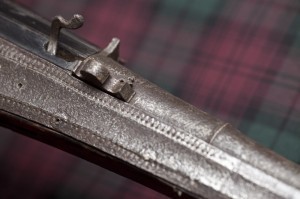 the day James Stewart was hanged the real culprit had to be held down at a house in Ballachulish to prevent him giving himself up. One of those who fell under suspicion was Stewart's half-brother, Alan Breck Stewart, who had stirred up anti-Campbell feeling among his clansmen. Robert Louis Stevenson took this idea as central to his novels Kidnapped and Catriona, which feature Alan Breck as one of the leading characters.
the day James Stewart was hanged the real culprit had to be held down at a house in Ballachulish to prevent him giving himself up. One of those who fell under suspicion was Stewart's half-brother, Alan Breck Stewart, who had stirred up anti-Campbell feeling among his clansmen. Robert Louis Stevenson took this idea as central to his novels Kidnapped and Catriona, which feature Alan Breck as one of the leading characters.
In 2001 a descendent of the Stewarts claimed that the murder was planned by four members of the Stewart family and that Donald Stewart of Ballachulish had fired the gun as he was the best shot. The weapon itself was found 200 years after the murder hidden in a hollow tree. Two musket balls had been fired and a single shot of powder used. It was known as the "black gun of misfortune and sorrow" and is now in the West Highland Museum.
The site of the murder is now commemorated with a memorial and it is an atmospheric place still deep in the woods at Lettermore and surrounded by the trees and steep slopes that helped the murderer to escape. It was a fascinating story and I enjoyed the opportunity to visit the place and hear the story that had inspired Kidnapped, one of my favourite classic stories.
I hope you've enjoyed the tale of the Red Fox. Please drop by next week for more Scottish history and my big holiday giveaway!
©2011 Nicola Cornick. All Rights Reserved.
.November 15, 2011
Scotland Day 1 – Jacobites!
Over the next few weeks I plan to post up some of the historical research I did on my recent, fabulous trip to Scotland and I hope you will find it interesting. It's no secret that I absolutely love Scotland (and I don't think I'm alone in that!) and relish my annual trips up there to visit family, walk in the Highlands and dig deep into Scottish history. So here we are: Day 1!
Scotland and I hope you will find it interesting. It's no secret that I absolutely love Scotland (and I don't think I'm alone in that!) and relish my annual trips up there to visit family, walk in the Highlands and dig deep into Scottish history. So here we are: Day 1!
On the first day of our holiday in Scotland we stayed at the wonderful Craiglinnhe House in Ballachulish in the Highlands and we were immediately plunged into the world of the Jacobites, the Glencoe Massacre and the Rising of 1719.
Ballachulish is very near Glencoe, scene of the infamous massacre in 1692 when members of the Clan MacDonald were murdered. We had driven through the glen earlier in the day in the pouring rain with the dark mountains lowering above us. Such a desolate and wild landscape was very atmospheric and it was all too easy to imagine the horror of the massacre on that winter day long ago. The rather splendid Glencoe Visitor Centre gives a nicely balanced view of the complicated history of the massacre which still rouses strong passions today.
On our way to Ballachulish we also stopped in Glenshiel at the monument to the Jacobite Rising of 1719. On that occasion the Jacobite Army had been reinforced with Spanish troops. "The nineteen" was another defeat in the attempts by the Jacobites to restore the exiled House of Stuart, attempts which culminated in the defeat of Bonnie Prince Charlie at the Battle of Culloden in 1746.
 The Battle of Glenshiel was on a small scale; less than a thousand men formed the Jacobite Army. They were led by John Cameron of Lochiel, Chief of Clan Cameron, alongside Lord George Murray and the Earl of Seaforth. Their supply base was Eilean Donan Castle and their plan was to advance upon and capture Inverness.
The Battle of Glenshiel was on a small scale; less than a thousand men formed the Jacobite Army. They were led by John Cameron of Lochiel, Chief of Clan Cameron, alongside Lord George Murray and the Earl of Seaforth. Their supply base was Eilean Donan Castle and their plan was to advance upon and capture Inverness.
The British government was aware of the plan and attacked Eilean Donan Castle from the sea, destroying it with the cannon fire of three warships. General Wightman, the Hanoverian commander, came from Inverness and confronted the Jacobites at Glenshiel on the 10th of June 1719.
Standing in Glenshiel in the rain it was difficult to see how the Jacobites could have lost with such a natural advantage in the terrain; they had blocked the road and their troops had fortified the tops and sides of the surrounding hills. Nevertheless they were driven from their positions and forced to retreat under shelling from the government troops. The Spanish fought bravely but by 9pm, three hours after battle had commenced, they were obliged to surrender and the remaining Jacobites fled into the fog.
The Battle of Glenshiel was lost largely as a result of the fact that the Jacobites were poorly armed, lacked provisions and also lacked support of the Lowlanders whom they had been relying upon to come out in favour of the uprising. The defeat at Glenshiel effectively ended the "Little Rising" of 1719 and the Jacobite leaders fled to the continent. This was a part of Jacobite history that I had not been at all familiar with and so it was very interesting to visit the monument in Glenshiel and read about the battle and it's place in the wider history of the Jacobite rebellions.
©2011 Nicola Cornick. All Rights Reserved.
.November 11, 2011
Mia Marlowe at the Word Wenches!
The lovely Mia Marlowe is my guest at Word Wenches today, talking about writing, research and her latest fabulous book! There's a giveaway too! http://bit.ly/uDo4ul
fabulous book! There's a giveaway too! http://bit.ly/uDo4ul
On the subject of giveaways, I am also giving away a copy of Desired on RomCon at the moment! http://bit.ly/usa3oj I am very excited that it is only three weeks until Desired is released and I've been bowled over by the lovely, lovely reviews that the book has been getting. Publishers Weekly talked about the engaging characters and intricate plot whilst Romantic Times hailed it as wonderfully sensual and entertaining. In the next few weeks there will be more about Desired on the blog, plus a big contest and giveaway to celebrate the publication of the book. The prize is a delicious collection of goodies from my recent trip to Scotland… And speaking of which, now that my photos are ready I shall be blogging about my trip next week!
Thank you for dropping by – it's lovely to be back in touch!
©2011 Nicola Cornick. All Rights Reserved.
.October 21, 2011
We're on a Break!
The Passion for History blog is on a break. Enjoy your reading, writing and history. See you in a couple of weeks!
weeks!
©2011 Nicola Cornick. All Rights Reserved.
.October 19, 2011
Arabian Nights!
Today I am reflecting on the historical roots of "desert romances." Not only is the sheikh hero hugely popular in contemporary romantic fiction but some historical authors are also[image error] turning to the genre. A few years ago Louise Allen wrote a wonderful Turkish-set novella called Desert Rake and Marguerite Kaye has written the fabulous Princes of the Desert trilogy which Romantic Times described as "Sensual, ravishing and funny, a must for all lovers of sheikh romance."
The beginning of the desert romance genre is often traced to 1919 when E M Hull published her famous novel "The Sheikh." However I recently saw a programme about the Arabian Nights that made me think that from an historical perspective the appeal of this fantasy version of the desert comes from further back in history.
The Arabian Nights, a fantasy version of the Middle East, is a series of tales of adventure, love and magic. The stories of the Arabian Nights have shaped our views of an exotic land and its people for hundreds of years. It was over 200 years ago that the story of Aladdin was first performed at Drury Lane Theatre in London. With its theme of wishes being granted and the triumph of the underdog, it is still a perennial favourite in pantomime, as is the rags to riches story of Ali Baba. Then there is the tale of Scheherazade, the Thousand and Ones Nights, which are a lesson in storytelling, ending as they do each night on a cliff-hanger. These tales originate in the oral storytelling traditions of the East. They create an atmosphere of enchantment that allows the imagination to fly.
 Antoine Galant, the first great French Arabist, was the first man to translate the ancient stories for a European audience. The ladies of the court of Louis XIV adored the translations and discussed them at their "salons," the reading groups of their day. There was already a fashion for reading fairytales; Red Riding Hood and Puss in Boots had become popular at the end of the 17th century. It was good timing that these new stories should emerge when there was a public appetite for them. Not only were they popular with the upper classes, they also filtered down to ordinary readers. This created a problem for Galant who could not write fast enough. He had a source in the Middle East who recounted them orally to him and then he wrote them down, embellishing them as he went. The stories were translated into all the European languages. Foreign editions sold well. Galant produced 12 volumes in 12 years!
Antoine Galant, the first great French Arabist, was the first man to translate the ancient stories for a European audience. The ladies of the court of Louis XIV adored the translations and discussed them at their "salons," the reading groups of their day. There was already a fashion for reading fairytales; Red Riding Hood and Puss in Boots had become popular at the end of the 17th century. It was good timing that these new stories should emerge when there was a public appetite for them. Not only were they popular with the upper classes, they also filtered down to ordinary readers. This created a problem for Galant who could not write fast enough. He had a source in the Middle East who recounted them orally to him and then he wrote them down, embellishing them as he went. The stories were translated into all the European languages. Foreign editions sold well. Galant produced 12 volumes in 12 years!
By 1706 the stories had reached Britain. A volume called "Arabian Nights Entertainments containing 1001 Stories" amazed and entranced the reading public. Popularity spread by word of mouth. Readers were captivated by the new and exotic forms of magic in the stories that were so different from western myths. In the stories characters have the power of flight; this representation of freedom fascinated the audience. The tales created a rich portrait of an exotic east with different clothing, exotic perfumes, spices and all manner of unfamiliar worlds.
One outcome of the books' popularity was a fashion for oriental furniture and design. Divans and ottomans filled the boudoir. Portraits were painted in oriental style, eastern clothing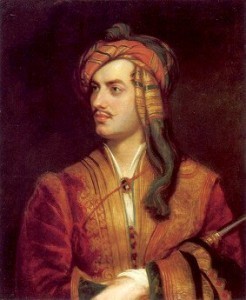 became popular, with turbans and dressing gowns and slippers designed in the oriental style. In 1711 the Earl of Shaftesbury denounced the Arabian Nights for "over-exciting the female imagination"! Dozens of cheap copies were printed and bookshops and stalls on street corners sold them for a few pence.
became popular, with turbans and dressing gowns and slippers designed in the oriental style. In 1711 the Earl of Shaftesbury denounced the Arabian Nights for "over-exciting the female imagination"! Dozens of cheap copies were printed and bookshops and stalls on street corners sold them for a few pence.
In 1788 The Arabian nights was turned into a drama and performed at the Theatre Royal in Covent Garden. The popularity of the stories with a Georgian audience was based in part on the way that the lives of ordinary people could be transformed through magic. They contained very contemporary and appealing themes. They were also stories that were full of sexual desire. An eighteenth century audience could deal quite comfortably with this. They were stories for a sophisticated audience who relished sensuality since they contained excess of all sorts, from eating and drinking to orgies!
The Victorians read the books avidly but by then their sexual content had been censored because it was considered too indecorous. They were adapted as stories for children and all the scandalous bits were cut out. Charles Dickens was a big fan and there are a number of references to the Arabian Nights in his books. The universal themes of the stories are part of their appeal, and their romantic and paranormal elements have fed into other genres of storytelling for hundreds of years.
In the present the stories still represent the exotic appeal of a different world with the ultimate in alpha heroes. I like to think that we have returned to the sophisticated world of the Georgians where an audience can appreciate the sensuality and desire of the stories! Do you enjoy stories with Sheikh heroes?
©2011 Nicola Cornick. All Rights Reserved.
.October 13, 2011
Regency Quiz!
The RNA's Regency Day last Saturday was splendid fun and thank you to all the organisers for the hard work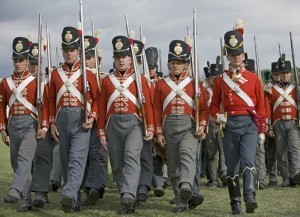 they put into making the day such a great mixture of events. There's a wonderful summary of the day here on the RNA blog. Thanks to Annie Burrows for that. It's impossible to pick out my favourite moments since I enjoyed every minute! The Regency redcoats added a certain je ne sais quoi to the event and having their escort on a walk through St James's was great fun. I enjoyed very much Jennifer Kloester's insightful and entertaining talk about her new biography of Georgette Heyer and the panel chaired by Jo Beverley that gave a very frank discussion of Sex and the Georgians. Louise Allen and Christina Courtenay's demonstration of Regency scents and perfumes was also an eye (or nose) opener! I'm not sure about heroes wearing sandalwood cologne now! Oh, and the Waterloo Tea was a high point!
they put into making the day such a great mixture of events. There's a wonderful summary of the day here on the RNA blog. Thanks to Annie Burrows for that. It's impossible to pick out my favourite moments since I enjoyed every minute! The Regency redcoats added a certain je ne sais quoi to the event and having their escort on a walk through St James's was great fun. I enjoyed very much Jennifer Kloester's insightful and entertaining talk about her new biography of Georgette Heyer and the panel chaired by Jo Beverley that gave a very frank discussion of Sex and the Georgians. Louise Allen and Christina Courtenay's demonstration of Regency scents and perfumes was also an eye (or nose) opener! I'm not sure about heroes wearing sandalwood cologne now! Oh, and the Waterloo Tea was a high point!
For those who would like a flavour of the event, here are some of the questions from the Regency Quiz. How many answers do you know? If you want to email me your answers at nicola@nicolacornick.co.uk I'll give a book to everyone who gets them correct!
1. Who said of Whom:
"Mad, bad and dangerous to know."
"Who is your fat friend?"
"Your arrogance, your conceit and your selfish disdain for the feelings of others…"
"She is poor, she has sunk from the comforts she was born to…"
2. The Regency
In which town did the Prince of Wales totally remodel a farmhouse?
Who led the British forces in Spain during the Peninsular War?
Who did George IV insist should be baptised Alexandrina (clue: I wrote about her here on my blog a few months ago!)
Who designed Regent Street?
In which hotel did Tsar Alexander I stay in 1814?
Who were the Prime Ministers during the Regency?
3. Literature
How many complete books did Jane Austen write and what were the names of her partially completed works?
What was the name of Jane Austen's sister?
In which Jane Austen book do the characters rehearse the play Lovers Vows?
What genre of fiction is Austen lampooning in Northanger Abbey?
In which Regency bachelor apartments did Georgette Heyer live from 1942 – 1966 (Clue: Dev lives there in Notorious!)
©2011 Nicola Cornick. All Rights Reserved.
.October 10, 2011
Favourite First Lines
Today the lovely Sara Trimble has invited me to join her to chat about hot starts and slowburning books. What is your favourite first line? Do you enjoy plunging straight into the story or do you enjoy a bit of build up? Come and chat with us about your favourite opening lines for the opportunity to win a copy of Notorious!
or do you enjoy a bit of build up? Come and chat with us about your favourite opening lines for the opportunity to win a copy of Notorious!
©2011 Nicola Cornick. All Rights Reserved.
.October 6, 2011
Devizes and (historical) Desires!
Yesterday I played truant for a morning and went out on a little research jaunt to Devizes, a Wiltshire market town with a fascinating history. Although the history of Devizes goes right back to the building of a motte and bailey castle after the Norman Conquest, it was the Georgian buildings that I particularly wanted to see. In the 18th century the wool trade brought prosperity to Devizes and throughout the Georgian and Regency period many of the medieval wooden buildings of the town were replaced by brick. I must admit that I did get distracted by some of the older houses, though, such as the Elizabethan St John's Alley, in this picture on the right!
town with a fascinating history. Although the history of Devizes goes right back to the building of a motte and bailey castle after the Norman Conquest, it was the Georgian buildings that I particularly wanted to see. In the 18th century the wool trade brought prosperity to Devizes and throughout the Georgian and Regency period many of the medieval wooden buildings of the town were replaced by brick. I must admit that I did get distracted by some of the older houses, though, such as the Elizabethan St John's Alley, in this picture on the right!
The Market Place is Devizes has been the site of a weekly market since the 13th century and it contains a market cross given to the town by Lord Sidmouth in 1814. He was MP for the Borough from 1784 – 1805 as well as Prime Minister from 1801 – 1804. Apparently he was unwilling to provide the market cross and it took the townspeople from 1797 to persuade him! The cross bears an odd account of the death of a woman called Ruth Pierce who dropped dead in the market place in 1753 after telling a lie. A salutary tale!
 The famous Regency artist Sir Thomas Lawrence lived at the Bear Hotel as a boy after his father became landlord in 1773. The inn became famous for the sketches that Thomas made of the customers. An increase in trade in the 18th century saw it extended in elegant Bath stone and with a wrought iron verandah. It also had its own assembly rooms which were rebuilt behind the hotel when the Victorian Corn Exchange was erected. Note the enormous long windows!
The famous Regency artist Sir Thomas Lawrence lived at the Bear Hotel as a boy after his father became landlord in 1773. The inn became famous for the sketches that Thomas made of the customers. An increase in trade in the 18th century saw it extended in elegant Bath stone and with a wrought iron verandah. It also had its own assembly rooms which were rebuilt behind the hotel when the Victorian Corn Exchange was erected. Note the enormous long windows!
The market place contains a number of other elegant Georgian buildings, one with a pretty shell hood over the front door. Number 17 is a grand town house and has a hipped roof, gate piers, blind pointing and contemporary stables. Northgate House is another fine Georgian building with another handsome porch. It was transformed from a coaching inn and was used as the lodgings for the Assize judges.
The Town Hall surprised me. It looked very Victorian to my (admittedly amateur) gaze but it was in fact built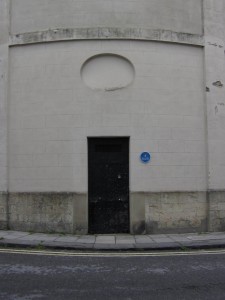 in 1806. Around the back was the town "lock up" for miscreants hauled in for breaking the law. it looks a bit grim, as you can see in the photo on the right!
in 1806. Around the back was the town "lock up" for miscreants hauled in for breaking the law. it looks a bit grim, as you can see in the photo on the right!
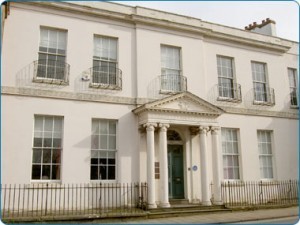 Long Street features some of the most impressive Georgian houses, double fronted with large gardens and in some cases side carriage entrances. Number 11, Lansdowne House, has a portico and delicate wrought iron balconies but looks a little past its Georgian splendour!
Long Street features some of the most impressive Georgian houses, double fronted with large gardens and in some cases side carriage entrances. Number 11, Lansdowne House, has a portico and delicate wrought iron balconies but looks a little past its Georgian splendour!
The history of Devizes proves that like many provincial market towns it had a far from sleepy existence. From the 18th century some local disturbances are recorded. A riot, connected with smuggling, occurred in 1765; another in 1795 was averted by the arrival of the Yeomanry and there was a third a year later. The last two were provoked by high food prices. A Militia riot in 1810, in which some townsmen and canal workers seemed keen to participate, was quelled by the Yeomanry. In 1817 a county meeting convened to congratulate the Prince Regent on his escape from assassination ended in disorder owing to hostility to 'Orator' Hunt, a fiery radical politician, who was in the crowd!
I was also fascinated to discover the derivation of the name Devizes, which comes from the Latin "Ad Divisas" meaning "on the boundary," a very unusual origin for an English place name.
©2011 Nicola Cornick. All Rights Reserved.
.October 4, 2011
Prizewinners!
Congratulations are in order! Firstly to Stella B, who won the September website contest with a prize of Whisper of Scandal and One Wicked Sin plus some goodies from Blenheim Palace. Also to Jane and to Michelle Aimee who won copies of Notorious in my recent blog contest. Thank you all for commenting and for being such fun people to chat with! Don't miss the next website contest where I am offering the first three Scandalous Women of the Ton books PLUS a Royal Wedding Celebration Pack!
Palace. Also to Jane and to Michelle Aimee who won copies of Notorious in my recent blog contest. Thank you all for commenting and for being such fun people to chat with! Don't miss the next website contest where I am offering the first three Scandalous Women of the Ton books PLUS a Royal Wedding Celebration Pack!
©2011 Nicola Cornick. All Rights Reserved.
.September 29, 2011
Who Do You Think You Are?
One aspect of Notorious that I expected to receive some comment upon and didn't was that the Irish hero, Sir James Devlin, was the holder of a hereditary knighthood. In the English system there are no hereditary knighthoods. Unlike a baronetage a knighthood cannot be passed on and is only held for life. However, there are three Irish hereditary knights, titles that have existed since feudal times. All three were conferred upon the FitzGerald family. These are The Knight of Kerry (the Green Knight), The Knight of Glin (the Black Knight), and The White Knight. To me these sound impossibly romantic – Sir Gawain and the Green Knight probably inspired me in this – even though I know some people think they sound more like something out of Monty Python!
system there are no hereditary knighthoods. Unlike a baronetage a knighthood cannot be passed on and is only held for life. However, there are three Irish hereditary knights, titles that have existed since feudal times. All three were conferred upon the FitzGerald family. These are The Knight of Kerry (the Green Knight), The Knight of Glin (the Black Knight), and The White Knight. To me these sound impossibly romantic – Sir Gawain and the Green Knight probably inspired me in this – even though I know some people think they sound more like something out of Monty Python!
By a twist of genealogical fate I am related to the FitzGerald knights on my father's side through descent from Princess Nest of Wales and so I thought it would be nice to give Devlin a title that commemorated that fact. The Irish knights have a long and fascinating history and it seemed to me that Devlin, explorer, sailor and adventurer, was worthy of following in their tradition. I'm fascinated by genealogy and often find that real life throws up some amazing stories that are far stranger than fiction.
Do you have any interesting ancestors? Who are you descended from – or who would you like to be related to? I'm offering two copies of Notorious to commenters between now and Monday!
©2011 Nicola Cornick. All Rights Reserved.
.


